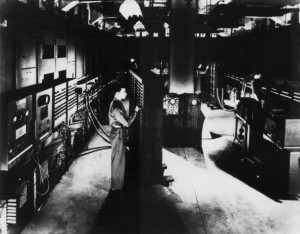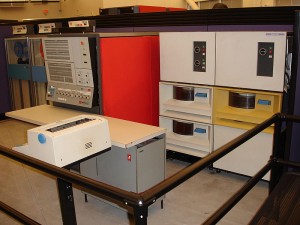You’ve heard the names, but do you know how they’re relevant? Join me for a trip down mainframe memory lane . . .
The concept of the single computer on a desktop — or in the palm of your hand — was an alien one for years. It’s underscored by the following quote, often misattributed to former IBM CEO Thomas J. Watson:
I think there is a world market for maybe five computers.
The philosophy of the early days of computing was one of mainframes. These were large, behemoth computers that filled rooms and required the attention of legions of scientists in white lab coats. The computers did massive operations, such as calculate missile trajectories or botch phone bills.
A single person using a computer? Poppycock! That would be like one person needing a nuclear missile for home defense.
Now, I’d love to have a nuke for home defense, but that’s not my point.
My point is to reminisce about those early monster computers, devices that would indeed fit into the palm of your hand if you were 90 miles tall.
Z1. The Z1 was the first programmable binary computer ever, making it the top of my list. It was developed by Konrad Zuse in the mid 1930s. It also holds the distinction of being the first computer destroyed by an air raid.
The Z1 was reconstructed by Zuse in 1986. It now sits in the German Museum of Technology, presumably safe from being bombed by the Allies a second time.
Colossus. The Colossus was the Allied counterpart to the German’s Z1, although Colossus was electronic whereas the Z1 was mechanical. It was used in for decrypting codes.
The Colossus was programmable, but only by throwing switches and re-writing. Apparently the Allies built ten of them by the end of the war. Colossus was designed by British engineer Tommy Flowers.
Eniac. The Eniac is one of my favorite early computers, probably because the name rhymes with maniac, as did so many of the early monster computers. Eniac is an acronym, so it should probably be capitalized: ENIAC. It stands for Electronic Numerical Integrator And Computer.
The ENIAC was designed to calculate missile trajectories. It’s also a bit controversial in computer history: The Atanasoff–Berry Computer, or ABC, predated the ENIAC as far as a electronic digital computing device. Apparently the ABC lacked the same public relations firm as the ENIAC.
Univac. The Univac was one of the most famous computers of the early age. It’s reputation comes from its successful prediction of the outcome of the 1952 presidential election. That probably did more harm that good, leading the general public to believe that the computer made the decision by its own intelligence as opposed to merely crunching data fed into it.
The Univac era marked the departure from computing machines used for military purposes to general-purpose information processing. It was the dawn of the mainframe era, where the computer was a central device used by many users on terminals located elsewhere.
IBM 360. Odds are good that if you worked on a “computer” in the 1960s or early 1970s, it was an IBM 360. It was the first general-purpose mainframe to serve both commercial and scientific purposes. It was also tremendously popular. In fact, if you’ve seen just about any film or TV show from the early 1970s that featured a “computer” then you were probably look at something inspired by the IBM 360, if not a 360 itself.
VAX. The VAX was the the mainframe popular during the late 1970s when the microcomputer revolution began. In fact, the VAX mainframe was still for sale as late as 2000, when it was finally discontinued.
Behemoth still exist today. Mainframes and supercomputers are still widely used today, although the monster machines that dominated the scene from the late 1930s through the 1970s are pretty much relics of the past.



